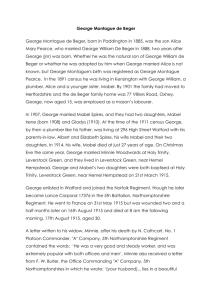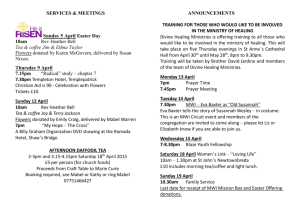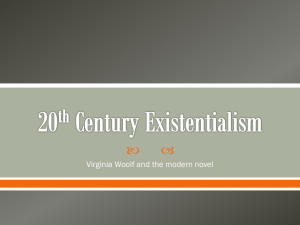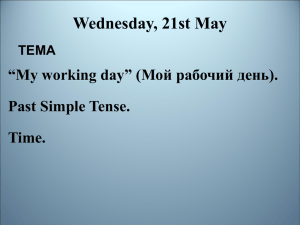The New Dress by Ola Ferwana and Aseel Mehjiz
advertisement
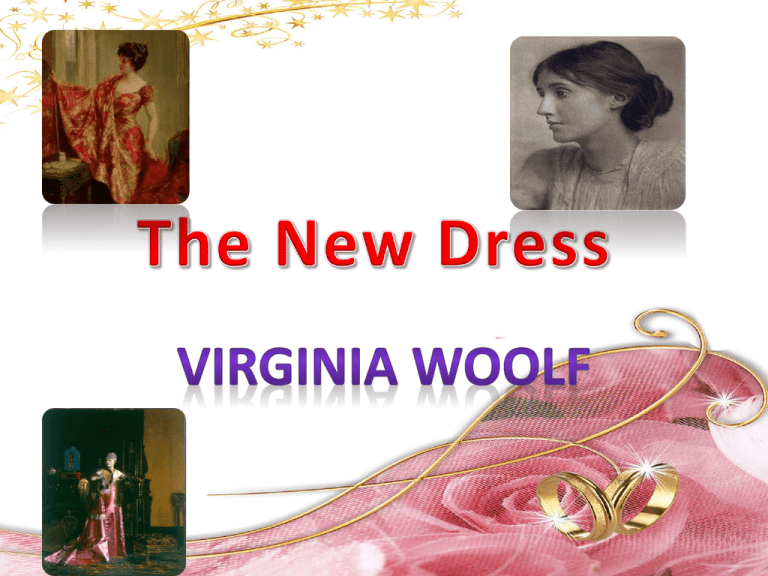
Author Biography Introduction summery Characters Style Themes Virginia Woolf was born Adeline Virginia Stephen in London on January 25, 1882, the third of four children of Julia Duckworth and Sir Leslie Stephen, a noted historian and biographer. As a child, Woolf received no formal education but made use of her father's library and literary friendships to educate herself. London. After her mother's death in 1895, Woolf experienced a nervous breakdown, the first in a series of four debilitating emotional traumas. When her father died nine years later, Woolf had her second mental breakdown. Upon her recovery, she moved with her sister, Vanessa, and her brothers, Thoby and Adrian, to the Bloomsbury district of Woolf is considered one of the greatest innovators in the English language. In her works she experimented with stream-ofconsciousness and the underlying psychological as well as emotional motives of characters. Woolf's reputation declined sharply after World War II, but her eminence was re-established with the surge of Feminist criticism in the 1970s Virginia Woolf's short story "The New Dress" was written in 1924 while she was writing the novel Mrs. Dalloway, published in 1925. Critics have entertained the possibility that the story may originally have been a chapter of the novel because some of the same characters and events appear in both works. It is a story about the feelings of a woman towards herself and her reaction to the behaviors of others when they meet her. • Mabel is wearing a yellow dress that she designed with her dressmaker specifically for this particular occasion. • she arrives at the party and removes her cloak • Immediately after greeting her hostess, she goes straight to a mirror at the far of the room to look at herself and is filled with misery at the conviction that ‘‘It was not right.’’ • She imagines the other guests exclaiming to themselves over ‘‘what a fright she looks! What a hideous new dress!’’ She begins to berate herself for trying to appear ‘‘original’’: • During her stay at the party she has several flashbacks which remind her of the moments at the dressmaker Miss Milan and of her past . • • ’ She thinks of the new dress as a ‘‘horror . . . idiotically old-fashioned. • At these occasions she always compares herself to a fly trying to get over the edge of a saucer • . At the end of the story she thinks about changing her life and leaves the party with this new feeling. Characters Mrs. Barnet is a maidservant in the Dalloway household. Her behavior in greeting Mabel Waring and taking her coat seem unremarkable to the reader, but sets off great waves of insecurity in the party guest about her appearance and social role. Clarissa Dalloway is the hostess of the party that Mabel attends. Clarissa is affable and courteous to her guests, and her presence lingers, though the reader only hears her speak once in the story— to encourage Mabel not to leave the party early. • Mabel Waring is a middle-aged woman who reflects constantly and, some might say, obsessively, about her alienation from the members of the elevated level of society she wants to join. When she is invited to a party given by the wealthy and socially prominent Clarissa Dalloway, she is overwhelmed with worry about her inability to dress fashionably Style • Stream of Consciousness Woolf's short story "The New Dress" is related through a stream-ofconsciousness narrative in which the thoughts and feelings of Mabel Waring are central to the narrative. The story follows her thoughts about the dress, about the party, about who she is and who she wishes to be. She tells herself that it is her choice not to be like the rest of them, but she also knows that she is envious of them and her final comment about her lying about enjoying herself at the party: ”Lies, lies, lies”, could equally be applied to everything she says to herself about being different on purpose. The story emerges from Mabel's thoughts as she perfunctorily addresses the other guests and her unconscious associations are evoked by a look or gesture. There is no logical progression of ideas in the story; they occur randomly, as Mabel's thoughts drift to and from the party The protagonist Mabel is not a very strong character and does not have much selfconfidence, that is why she can be easily influenced by others. She uses flashbacks to escape the reality but these happy feelings are only temporary. At the end nothing has really changed for Mabel and she will always stay the way she is. • • The story is told from an anonymous, third-person perspective. In a stream-ofconsciousness narrative, the narrator knows the inner thoughts of the protagonist Alienation and Loneliness Mabel Waring's feelings of alienation surface when she attends a party given by Clarissa Dalloway. The reader first sees her insecurity when the Dalloways's servant, Mrs. Barnet, immediately recognizes Mabel's humble origins from the new dress that she has had made for the party. Although the other guests engage Mabel in conversation, an acute selfconsciousness about her appearance and manners makes her unable to communicate on anything other than a superficial level. Mabel's self-absorption and selfcenteredness isolate her from the other party guests and make any communication impossible. Wrapped up in her own world, she never carefully considers what others say; instead, Mabel assumes that everything at the party somehow involves her and make fun of her Lack self-confidence and communication • The protagonist Mabel is not a very strong character and does not have much self-confidence, that is why she can be easily influenced by others. • She thinks that every one make fun of her appearance • The story focuses mainly on Mabel’s feelings of inadequacy at this party, which are represented by the dress she is wearing. Although she thought the dress to be fashionably oldfashioned, she realizes, once at the party, how different she (and her dress) is from the rest of them, who are “dressed in the height of the fashion” Social Class • When Mabel first sees herself in the mirror in the privacy of the workroom, she learns that "what she had dreamed of herself was there— a beautiful woman." She was "the core of herself, the soul of herself" (7). • However, in Mrs. Dalloway’s drawing-room, "woken wide awake to reality"(8), she perceives her image as "repulsive" and reconsiders her course of action to have been pointless . Her attempt to reinvent a selfimage and her view of the "core of herself" as "a beautiful woman" are destroyed (9). • Under the social coercions of the party, Mabel questions and alters her selfimage. What is true is no more her original and self-made self at Miss Milan’s: "This was true," she confirms, "this drawing-room, this self, the other false" (10). Mabel’s internalized gender and class insecurities cause her to undergo a psychological transformation in the public space of the party Clothing as a metaphor for gender and class restriction • Mabel hates her chosen dress precisely because it does what she has previously wished it to do: to display her unique identity. She feels that all the guests are thinking, "What a fright she looks! What a hideous new dress!"(13), and even becomes paranoid. When Rose Shaw tells her the dress is "perfectly charming" (14), Mabel is certain that she has derided her. • Even when others discuss issues related to their own lives, she imagines they are exchanging secret messages about her appearance. In this context, clothing clearly substitutes social coercions and the ways in which they exercise power and control over Mabel’s personal identity, prompting her to abandon all agency regarding her identity. Mirror as a metaphor for the power of sexism and classism • Mirror is a symbolic tool that brings about Mabel’s endless "reflections" of insecurity, embarrassment and agony. It is the symbolic tool of a societal sexism reflecting dot-sized images of women. While listening to Mrs. Holmes, Mabel sees her own reflection in the mirror as a "yellow dot" and that of Mrs. Holman as a "black dot" or a "black button."

